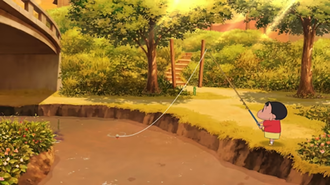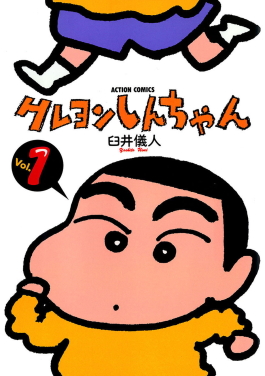
Crayon Shin-chan is a Japanese manga series written and illustrated by Yoshito Usui. Crayon Shin-chan made its first appearance in 1990 in a Japanese weekly magazine called Weekly Manga Action, which was published by Futabasha. Due to the death of author Yoshito Usui, the manga in its original form ended on September 11, 2009. A new manga began in the summer of 2010 by members of Usui's team, titled New Crayon Shin-chan.

Keiichi Hara is a Japanese director of animated films.

Boku no Natsuyasumi is an adventure video game developed by Millennium Kitchen and directed, written, and designed by Kaz Ayabe. It was published by Sony Computer Entertainment and released in Japan on the PlayStation on June 22, 2000. The game follows the summer vacation of Boku, a city-dwelling nine-year-old boy who in August 1975 is sent to stay with his extended family in the Japanese countryside for a month. Gameplay takes place in an open-ended environment where the player is free to determine how Boku spends the thirty-one in-game days of his summer vacation, with few set goals or specific obligations of gameplay progression.

Crayon Shin-Chan: Ora to Poi Poi is a video game for the Family Computer based on the series Crayon Shin-Chan. It was developed by TOSE and published by Bandai on August 27, 1993, in Japan only. A version of the game was simultaneously released to accommodate the Famicom's Datach Joint Rom System attachment but lacked any features that utilized the Datach's card reading capabilities.

Crayon Shin-chan: Action Mask vs. Leotard Devil, also known as Action Mask vs High - Gure Satan, is a Japanese language animation film from the Crayon Shin-chan series. It was Shin-chan's first anime movie released in 1993.

Crayon Shin-chan: The Hidden Treasure of the Buri Buri Kingdom is a 1994 Japanese anime film produced by Shin-Ei Animation. It is the 2nd film of the anime series Crayon Shin-chan.

Crayon Shin-chan: The Storm Called: The Adult Empire Strikes Back is a Japanese anime film released on April 21, 2001. It is the ninth installment of the Crayon Shin-chan series. The name is a reference to The Empire Strikes Back. It was released as Crayon Shinchan The Movie: Counter Attacking the Adult's Empire with English subtitles on VCD and DVD by PMP Entertainment.
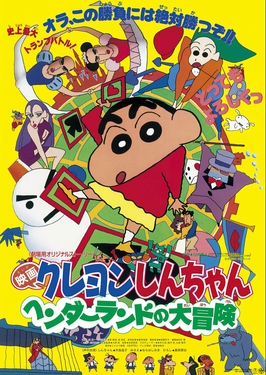
Crayon Shin-chan: Great Adventure in Henderland is a 1996 Japanese anime film produced by Shin-Ei Animation. It is the 4th film of the anime series Crayon Shin-chan.
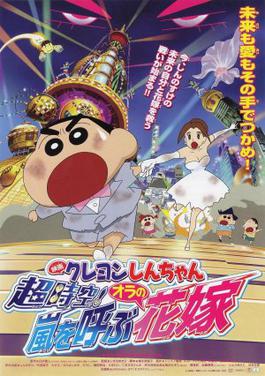
Crayon Shin-chan: Super-Dimension! The Storm Called My Bride, also known as My Bridge Through Space and Time, is a 2010 Japanese anime film. It is the 18th film based on the popular comedy manga and anime series Crayon Shin-chan.

Crayon Shin-chan: Blitzkrieg! Pig's Hoof's Secret Mission, also known as Tip and Run! Pig Hoof Battle!, is a 1998 anime film. It is the sixth film based on the popular comedy manga and anime series Crayon Shin-chan. The film was released to theatres on April 18, 1998 in Japan.

Crayon Shin-chan: Fierceness That Invites Storm! Me and the Space Princess, also known as Shin Chan, Me and the Space Princess, is a 2012 Japanese anime film. The film celebrates the 20th anniversary of Crayon Shin-chan anime. It is the 20th film based on the popular comedy manga and anime series Crayon Shin-chan.
Millennium Kitchen Co., Ltd. is a Japanese video game developer. Founded by Kaz Ayabe in 1997, the company is best known as the creators of the Boku no Natsuyasumi (lit. series of video games.

Crayon Shin-chan: Intense Battle! Robo Dad Strikes Back is a 2014 Japanese comic science fiction anime film produced by Shogakukan. It is the 22nd film of the popular comedy manga and anime series Crayon Shin-chan, released in Japanese theaters on 19 April 2014. It is directed by Wataru Takahashi and the script is written by Kazuki Nakashima of Kill la Kill. The story of the movie was published as manga in the October issue of Manga Town, with script written by Nakashima and art by Aiba Kenta. This film was nominated for the Japanese Media Arts Festival in the animation award category.
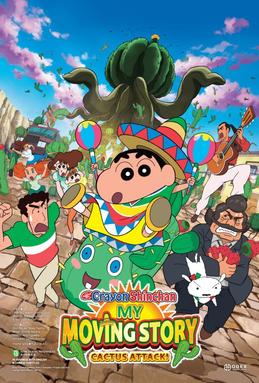
Crayon Shin-chan: My Moving Story! Cactus Large Attack! is a 2015 Japanese anime film produced by Shin-Ei Animation. It is the 23rd film of the popular comedy manga and anime series Crayon Shin-chan. It was released on 18 April 2015 in Japanese theatres. It is directed by Masakazu Hashimoto, who also directed the 21st movie Very Tasty! B-class Gourmet Survival!!. The screenplay was written by Ueno Kimiko. The movie focuses on the Nohara family's battle with a carnivorous cactus species after moving to the fictional town of Madakueruyobaka in Mexico.
Crayon Shin-chan Spin-off is an anime television series and a spin-off of Crayon Shin-chan. Amazon Japan exclusively streamed the spin-off, with all seasons consisting of 13 episodes of about seven minutes each.
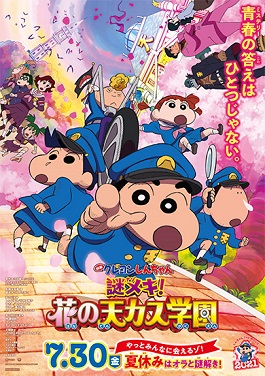
Crayon Shin-chan: Shrouded in Mystery! The Flowers of Tenkasu Academy is a 2021 Japanese anime film produced by Shin-Ei Animation. It is the 29th film of the anime series Crayon Shin-chan. The director of the film is Wataru Takahashi and screenplay is written by Kimiko Ueno.

Crayon Shin-chan: Mononoke Ninja Chinpūden is a 2022 Japanese animated film produced by Shin-Ei Animation. It is the 30th film of the anime series Crayon Shin-chan. The film is directed by Masakazu Hashimoto and the screenplay is written by both Masakazu Hashimoto and Kimiko Ueno. The film was released on 22 April 2022.
Kazuhiro Ayabe is a Japanese video game developer. He is the founder of the video game company Millennium Kitchen and the creator of the video game series Boku no Natsuyasumi.
Crayon Shin-chan: Ora's Dinosaur Diary is a 2024 Japanese anime film produced by Shin-Ei Animation. It is the 32nd film movie of the anime series Crayon Shin-chan.


